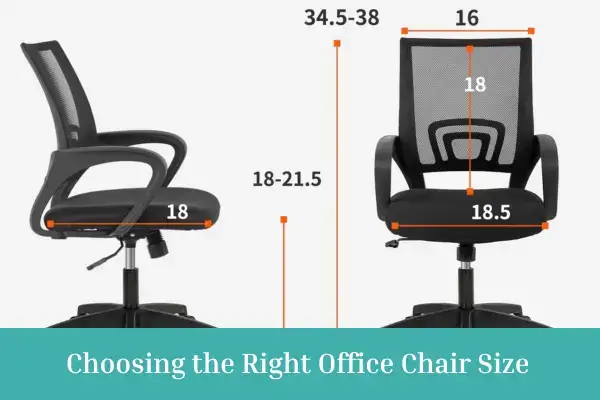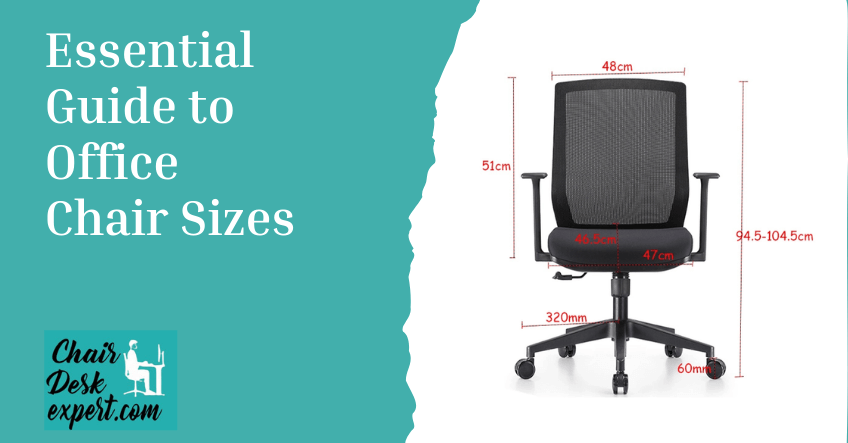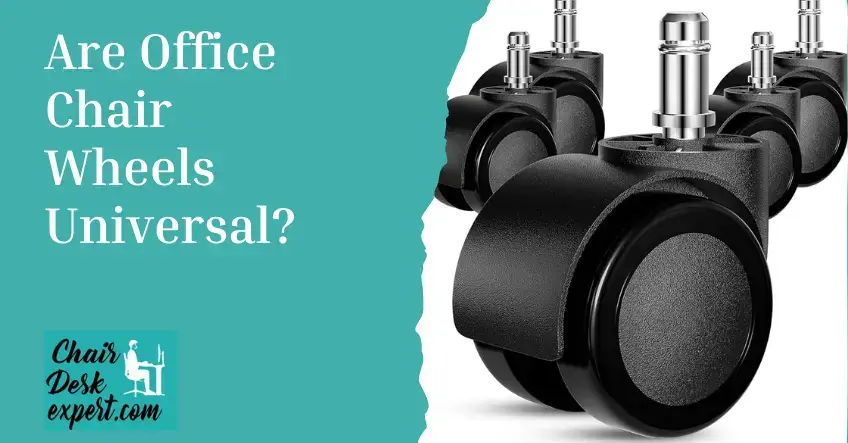For improved productivity, comfort, and pain management purposes, selecting an office chair that suits your needs is important.
What should be considered when choosing ergonomic office chair sizes? When comparing the measurements on an office chair, some significant aspects should be considered.
The first step is to look at the actual dimensions of the chair and then consider the size of the intended user.
However, one should also consider the size of one’s desk about size and height. Keep reading this article to learn how you can understand more about the sizes of office chairs.
Choosing the Right Office Chair Size

Make sure that when you pick a chair, its seat height can be adjusted so your feet are flat on the floor, or a footrest can be used.
Furthermore, look at how deep it is between your hips and knees since there should only be one or two inches left from the front edge of the seat surface to the back knee area for convenient seating.
The basic dimensions of an office chair size
There’s a wide variety available on the market with different dimensions depending on needs. You must, therefore, choose a seat that is appropriate for you by considering factors such as height, body type, etc. Here are three main types based on their sizes:
>> Read Also: Ergonomic Office Chair For Sciatica
Petite Office Chairs:
This means they are smaller than usual, as they accommodate small individuals who use them even at home, unlike others who prefer sticking to normal versions.
Standard Office Chairs:
These are designed for average adults weighing about 250 pounds, which makes them suitable in most cases; however, there may still exist discrepancies due to either because of room arrangement (for example, low ceilings) or people being outside this average range (e.g., taller men).
READ MORE:>>> best office chair under #200
Oversized Office Chairs:
They are meant for people with heights above six feet; hence, they have more significant dimensions and capabilities, like supporting up to five hundred pounds.
Although no specific standard dimensions exist for all office chairs in general, most fall within these ranges:
- Chair Height: 16-20 inches
- Chair Width: 19-21 inches
- Chair Depth: 15-19 inches
The average size of a typical office chair may vary depending on factors like the height of its backrest or the presence of a neckrest.
Typically, such chairs measure between thirty-one and forty inches in height from the floor’s topmost point located at the backside.
>> Read Also: Where Should Lumbar Support Be on The Office Chair?
What Size Office Chair Should I Get?
Many people believe that office chairs are made in a one-size-fits-all fashion. Task seating is created to suit each person, depending on their body type.
As everyone has a different build, selecting the right chair designed uniquely for your body shape is important. If you want to know whether purchasing a new chair is the ideal size, then follow this guide:
Standard-Size Office Chairs:
Among other individuals, most people normally find standard-size chairs very comfortable. Standard-sized office chairs can typically accommodate weights up to 250 pounds and suit persons between 5’5″ and 6 feet tall.
However, additional aspects, such as the back height of the chair and ergonomic adjustments, should be considered so as not to buy an inappropriate seat (Frymoyer,1999).
Good ergonomics are essential in standard size and throughout all models of seating devices within offices.
Smaller office chairs are designed for individuals up to 5 feet 4 inches tall. These chairs have shorter cylinders and smaller seat pans than those used by taller people, but they can still support at least 250 lbs.
Standard seat pans make the back of the knee uncomfortable for petites. At the same time, an overgrown cylinder can leave its legs hanging without any support. Petite chairs do this by minimizing, which enables the short in height to get proper backrests.
>> Read Also: Are Office Chair Wheels Universal
Big and Tall Office Chairs:
These office chairs are meant for persons weighing over 250 pounds or standing over six feet tall. They feature larger seats, backs, and higher-reaching cylinders than ordinary stools.
The base of such a chair is often reinforced to provide more excellent stability under heavier loads. It has been designed explicitly with more significant users in mind.
By knowing your body measurements or specific requirements, you can choose the right size of an office chair that will be comfortable and supportive during prolonged working hours.
Does the ideal office chair exist? – A question about its altitude
So does it mean there is an ideal office chair height that will bring a revelation and a levitation? Well, if not quite this way, from an ergonomics perspective, yes, there is an optimized chair height as you work with different parts of your body on it.
However;
Feet Firmly Touching the Floor:
The best case scenario would be having knees bent at ninety degrees with both feet flat on the ground. This way, you’ll feel supported properly, hence lowering pressure on the lower part of your body. Keep adjusting until you reach such a position.
Forearms Parallel to the Desk:
Getting forearms at the appropriate level is important for people working at desks, particularly computers.
The open angle between 90-100 degrees at the elbow should make sure forearms come parallelly to the desk surface or slope towards it slightly, lessening suggests comfort relaxation arms fatigue.
Balancing these two factors is the key to getting the perfect chair height. Adjusting the height of your chair, which meets both of these criteria, can greatly improve your comfort and provide you with better ergonomics while working.
Remember that it is easier to adjust foot position using a footrest than arm height without an adjustable desk or keyboard tray adjustment.
Therefore, while the idea of a perfect office chair doesn’t make one levitate or get enlightened, it ensures convenience when working longer by reducing fatigue and discomfort.
>> Read Also: Are Ergonomic Office Chairs Worth It
Why is it Important to Have an Ergonomic Office Chair?
A large fraction of people spend five to eight hours sitting on a chair every day seated at their desks. Chairs that are not precisely configured lead to physical strain for some time.
This means that as much as someone might be present in the workplace for several minutes only or many hours due to their occupation, sitting on an ordinary seat with no proper sizes can lead to this condition after some time.
For instance, when you sit at the table all day without taking breaks, it can damage your soft tissues, causing chronic pain and discomfort if not checked properly.
Read more : >>>>
According to OSHA estimates quoted by the U.S. Department of Labor, more than two million workers develop musculoskeletal disorders at work because they spend long periods doing desk jobs. Consequently, going for an ergonomic office chair is highly recommended.
Many people do not realize the importance of investing in good quality chairs despite sitting most of their days.
Prolonged use of unsupportive and poorly designed chairs can cause more than just lower back pain. They result in increased tiredness with higher risks, such as sleepiness throughout the day, headache troubles often experienced by individuals who have migraines, obesity problems including diabetes mellitus type II (insulin-resistant syndrome), slipped discs, and other orthopedic issues related mainly to spine structures.
READ MORE:>>> What Is The Most Comfortable Chair For Extended Hours?
A well-designed seat offers appropriate backbone and lumbar comfort, reducing the strain on the back muscles.
It also helps in better posture, letting one breathe easily and minimizing fatigue, hence increasing concentration.
Investment in a comfortable chair for the office not only enhances physical well-being but increases productivity as well as satisfaction at work.
Ergonomic Office Chairs
Designed specifically to support the human body, ergonomic chairs are tailored to provide comfort and reduce discomfort by incorporating specific features and dimensions. Compared to ordinary chairs, these seats have many features that make them unique.
>> Read Also: Which Office Chair Is Good For Back Pain
Key Features And Dimensions Of Ergonomic Office Chairs
Below are the key features and dimensions of ergonomic office chair size.
Seat Height:
A good ergonomic chair should have an adjustable seat height to accommodate people of different sizes and let their feet rest flat on the floor while sitting.
Seat Width and Depth:
The seat depth should be two to four inches between the chair’s edge and the back of your knees for proper circulation and comfort.
Seat Tilt:
Ergonomic chairs often have a tilt seat, which helps maintain proper pelvic positioning by preventing anterior pelvic tilt, commonly experienced by people who sit for long hours.
Backrest Lumbar Support:
Adjustable lumbar support retains the natural spine “S” shape, thus preventing slumping over or pressure on both the spine and pelvis.
Reclining Backrest:
The reclining feature helps to relieve some pressure from our upper body parts, including shoulders, and gives some relief to our back muscles during prolonged sitting positions, bringing about relaxation when one is tired.
Swivel Function:
Its bottom part can spin, allowing easy movement with less straining involved, reaching out to different areas without necessarily having twists or pains in several parts of your body.
Armrests:
Armrests are included on most ergonomic office chairs to ease the tension around the shoulder region since they help relax this part while working.
However, it is important not to rely too much on armrests whenever you type so as not to get wrist and forearm strains while typing, thereby maintaining good ergonomics.
Headrest:
Headrests, when in place, support the upper neck and the back of your head so tension is kept out from the upper chest and shoulders, leading to improved comfort levels.
Wheels:
Premium ergonomic chairs are designed with wheels that allow free movement without straining your back. The floor type determines the kind of wheels used; for instance, softer wheels are used for hard floors, and stronger ones for carpeting.
Moreover, these types of office seats are built with specific materials that are known for their comfort and durability.
Some materials may be used along with various measurements for the office chairs (including leather and budget-friendly options), making them affordable. Having a well-made ergonomic chair guarantees maximum satisfaction while sitting at all times.
>> Read Also: Office Chair Explosion Incidents
Final Verdict
Choosing the right office chair size is crucial for user comfort, support, and performance. The chair’s dimensions, such as height, depth, width, armrests, and lumbar support, should be appropriate, promoting good posture and reducing discomfort or pain caused by prolonged sitting hours.
By taking accurate measurements and making proper adjustments, people can find the perfect fitting furniture, improving workplace efficiency while promoting healthier bodies.
Choosing an appropriately sized office chair is critical because it can hinder smooth working conditions, leading to an unhealthy office environment.
FAQs!
1-Why are office chairs made with wheels?
The main purpose of having wheels on office chairs is to enable users to move around without having to stand up. This feature was initially introduced by Charles Darwin in his laboratory to improve productivity in workplaces. Most modern office chairs have five legs for standing firmly on wheel platforms.
What does lumbar support mean about office chairs?
Lumbar support refers to a specific kind of lower back support offered by certain types of office seats. When seated, this is built into their designs so that they fit snugly against the lower back portion, thereby encouraging natural spinal alignment and providing relief from lower back muscle strain.
How high should an ergonomic desk chair be?
The best height for a desk chair is just below the kneecap when standing. Your desk chair should be adjusted to this height so that your feet can rest on the ground while your knees are at a comfortable 90° angle, which allows for good posture and reduces the chances of discomfort or injury from long periods of sitting.
What are the dimensions of office chairs?
Different office chairs come in different height ranges; however, if you measure from seat to floor, computer chairs range from about 16 to 21 inches.
How do I measure an office chair?
The seat width of a chair plays a crucial role in providing appropriate support and comfort. Sit on top of a tape measure with one end touching the widest part of your thighs to determine your needed seat width accurately. Take note of the reading on the opposite side.
Source Link:









